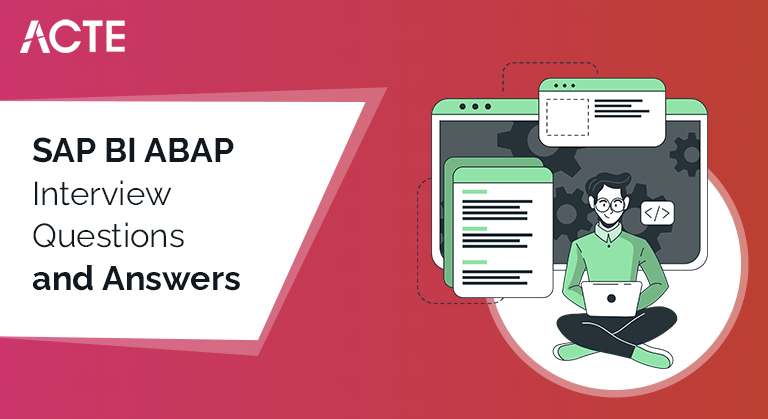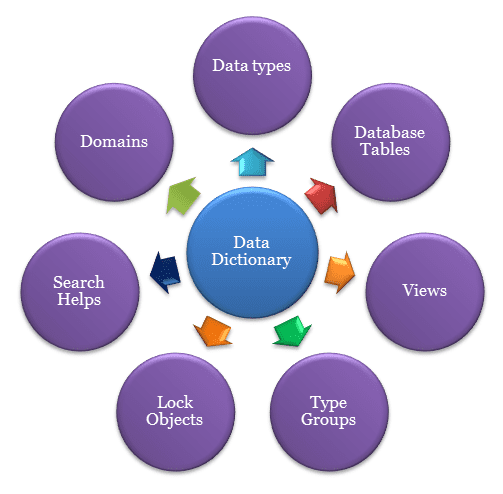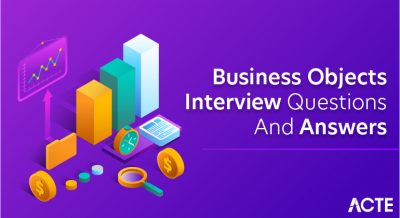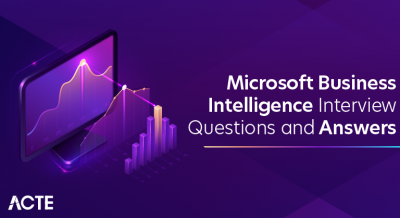
Are you planning to attend an interview for the SAP BI ABAP Developer role but confused on how to crack that interview and also what would be the most probable SAP BI ABAP Interview Questions that the interviewer may ask? Well, you have reached the right place. ACTE has collected the most frequently asked SAP BI ABAP Interview Questions which are often asked in multiple interviews.
1. How do SAP ABAP and BI/BW compare?
Ans:
- It works better.Its efficiency is lower than that of the ABAP.
- It is able to endure huge data loads and be relied upon for substantial amounts of the same.It performs best for less demanding data requirements.
- Its structure is multi-dimensional and related.Its structure is purely relational.
2. How experienced are you in the SAP BI ABAP Star routines?
Ans:
They are often taken into account for all data packages and help ensure that all rules that determine execution are carried out correctly. It is easy to take into consideration all of the highly sophisticated computations for a crucial figure. They often don’t contain any return values. It is possible to complete all of the preliminary computations at once when it comes to storing them in third-party structures.
3. What is the alternative that you can think about using to change the Open Hub data?
Ans:
The SAP DI ABAP’s BADI option can be used for this the alternative that you can think about using to change the Open Hub data
4. Can you clarify what you mean when you say “Info Cube”?
Ans:
It is essentially a star schema method that comes in handy when you need to access useful tables but are having trouble doing so since DIM tables are obscuring them. The aggregated data can be placed into the cubes easily and with little difficulty. With this method, users don’t need to spend a lot of effort keeping up the pace.
5. What are SAP/BI’s primary domains and functions?
Ans:
Planning and Analysis : Making use of the data kept in the data warehouse.
Broadcast publishing : Sending information to staff members via fax, email, etc.
Reporting : BI offers tools for reporting in Excel, web browsers, and other formats.
6. In what sense is an information object an information provider?
Ans:
An information object may have the ability to function as an information provider. There is a default option in SAP BI ABAP that can be chosen if there is a requirement to report on user data or characters. This option provides information on several elements of the object. It follows that a great deal of valuable information may be derived from the Info objects.
7. Why is intelligence so important in today’s businesses?
Ans:
There are many reasons why intelligence is important. It just ensures that user data is driven and that it can be used to make decisions about what to ignore or accept. Furthermore, with this technique, users are free to ensure that objects can extend beyond their true scope. Since intelligence just removes a great deal of error, all users are free to simply keep up with it.
8. How would you describe SAP BI ABAP as a useful tool for business intelligence?
Ans:
For no other reason than these, consumers from all over the world are contemplating it because of key aspects that make it the greatest. Multiple sources can be simply accessed at the same time. The data can be transformed into reports, which can then be used to analyze tasks in more detail. Simply put, the user-friendly GUI ensures that no compatibility or other concerns are detected. One may effortlessly examine various data sources, and the finest aspect is that SAP BI ABAP is an extremely scalable business intelligence platform. Additionally, consumers can be guaranteed seamless interaction with all other domains and superior query performance.
9. Could you clarify the definition of modeling and its significance?
Ans:
It is essentially a method that helps business owners to ensure that they have an excellent database. In actuality, the organization’s adopted schema heavily influences the design of the same, and lack of schema typically results in a number of limits. SAP BI ABAP ensures that these obstacles can readily removed. Businesses can also ensure that all tables are properly represented and that they are related to one another.
10. What do the update rule’s conversion routines for currencies and units mean?
Ans:
This option allows us to write ABAP code to convert units and currencies. The unit of Key Figure appears in the ABAP code as an additional parameter if this flag is enabled. For instance, we can convert pounds to kilograms.
11. Could you elaborate on the specific applications of business statistics?
Ans:
They are essentially thought of as a collection of Info cubes in charge of creating the Business Content and outlining some crucial rules. Users have the option to utilise them to gauge how well query handling and load monitoring perform. Additionally, precise details about how aggregates are used can be displayed.
12. Can users load data from a flat file, and if so, what are their options?
Ans:
For users, it is indeed feasible. In general, there are three reliable solutions that are significant for this. These include Additive Delta, Full Upload, and New Status for updated records.
13. What are some of the key extractor kinds that utilized in Advanced Business Application Programming?
Ans:
Information FI pertaining to Business Warehouse
- FI-SL
- View in DB
- Extractor
14. How do ODS, Multi-provider, and CUBE compare?
Ans:
- ODS is in charge of giving users all the detailed information they require in order to carry out certain necessary functions or to manage significant activities in Advanced Business Application Programming. The information in ODS is always perfect for drilling down.
- There is no physical data present in the multi-provider strategy. It enables consumers to obtain data from different information providers that vary in type and location. Many users think about it for sophisticated reporting.
- In actuality, CUBE is predicated on the star schema and only depends on it. Users are able to take it into account for their primary reporting as well.
15. What knowledge do you have regarding the Star Schema?
Ans:
Usually, dimensional tables are in charge of encircling other tables and the dimensional table. Not all fact tables are small enough to be taken into account right away in the domain. They may carry a very big quantity of records. On the other hand, the Star Schema Approach’s dimensional tables are tiny. While master data often makes up the Dimensional Table, transactional data is still included in the Fact table.
16. What issues did you run into when working with SAP BI ABAP?
Ans:
Depending on the amount of data, problems like master data redundancy may occasionally arise. This typically occurs when a record persists in many dimensional tables. Adopting the extended star schema carefully can address this problem.
17. What are the names of the routines that the information object level defines?
Ans:
These are Update Routines, and they resemble Star Routine in many ways. The data supplier is generally unconcerned about them. With them, it is simple to define all of the global data and the global check.
18. Which procedures can be taken into consideration while gaining access to the Info Package, and why?
Ans:
The ones that are up for consideration are the star routines. This is due to the fact that they consistently update the data goals and are generally free from all types of computation problems. One of the most important responsibilities of the SAP BI Advanced Business application Programming management is to do the same.
19. How may Open SQL and Native SQL be distinguished from one another?
Ans:
Through the usage of Open SQL, users may easily access all of the database tables that the SAP system is already familiar with. The database maker is unconcerned about this. The Native SQL is unable to offer the same. Actually, it functions flawlessly on the independent database system. While a few commands are shared by each, same tasks on each need differing amounts of time to complete.
20. Does the Dimensions vary with time?
Ans:
In SAP BI ABAP, dimensions typically represent static attributes like product categories. While dimensions themselves don’t vary with time, considerations for handling historical data and changes over time are crucial. Developers focus on managing slowly changing dimensions and time-dependent hierarchies to ensure accurate and historical reporting in data models.
21. Can the users optimize the dimensions in Advanced Business Applications Programming?
Ans:
It is feasible, yes. In reality, it’s an easy task, so there’s nothing to be concerned about. It is simple and limitless to generate dimensions. Users just need to ensure that the dimensions do not exceed twenty percent of the table size that is designated for the task.
22. Can you provide any knowledge you may have regarding the unit conversion procedures?
Ans:
In this setting, writing Advanced Business Application Programming codes is always necessary. All that has to be done is select this option. Users only need to ensure that the units are converted into other easily with just a few clicks.
23. How well-versed are you in the Open Hub Service?
Ans:
In fact, this is a possibility that is taken into consideration when it comes to quickly sharing data between the BW systems and the other application. The controlled distribution of data is ensured by the involvement of numerous systems. The users can effortlessly specify the data’s source and destination. All that a central monitoring policy does is ensure that the intended and preferred results occur.
24. What are the data kinds that are utilized for the Info Object characteristic?
Ans:
The data types utilized for the characteristic in info objects are as follows:TIMS, NUMC, HAR, DATS
25. How much do you know about the types of buffers in SAP BI?
Ans:
When using SAP BI ABAP, it is frequently necessary to temporarily store the data. The buffers are used for the same purpose. The two crucial buffers that users have access to at all times are the Roll Buffer and the Page Buffer.
26. How well-versed in primary indexes are you?
Ans:
26) How well-versed in primary indexes are you? Essentially, it is an index that includes the crucial or significant fields. A pointer to the non-key fields still in the table is also included. The SAP environment automatically creates this index, which is a good thing. The best thing is that once the references are made, users are free to specify them. And they are so eliminating the identical. This ensures that they are available to users whenever they need to use them to complete record-related tasks.
27. What are SAP Lock Objects, and how can you use them?
Ans:
These items help store data for a predetermined amount of time. Usually, they are used to hold the same for a specific field.
28. Can a selection button be added to the selection screen?
Ans:
Indeed, it is feasible and straightforward to deploy the parameters for this activity.
29. In SAP BI ABAP, what does the table partition mean?
Ans:
SAP is improving performance by leveraging fact table partitioning. Partitions can only be made on 0CALMONTH or 0FISCPER.
30. What is an Infocube?
Ans:
An info cube is a multidimensional dataset or extended structured star schema in which several dimension tables encircle a fact table—utilized further for BEx query analysis.
31. How does ST05 fit into the performance tweaking process?
Ans:
ST05 is a transaction code in SAP that is used for SQL Trace. It is a tool within SAP’s performance tuning arsenal that allows users to trace the execution of SQL statements in the database. Here’s how ST05 fits into the performance tweaking process :
- Identifying Performance Bottlenecks
- Analyzing SQL Execution
- Optimizing SQL Statements
32. How will the date be written in BW?
Ans:
Date formats in SAP Business Warehouse (BW) are usually standardised and adhere to a particular format. YYYYMMDD is the typical date format used in SAP BW, where :
- YYYY stands for the year with four digits.
- MM stands for the month with two digits.
- DD stands for the day with two digits.
33. Can you explain SAP R/3?
Ans:
| Component | Description | |
| Presentation Layer |
The user interface or front-end layer where users interact with the system. It includes graphical interfaces, web interfaces, or other user-friendly applications. | |
| Application Layer | The core processing layer responsible for executing business logic and managing various business processes. It includes modules for different functional areas like finance, sales, and production. | |
| Database Layer | The layer responsible for storing and retrieving data. It manages the data required by the application layer and ensures data consistency and integrity. It typically involves a relational database management system (RDBMS). |
34. In what ways is it possible to access a SAP system?
Ans:
There are two ways for users to access a SAP system. o Via the SAP GUI or Via an online browser It’s known as a front-end. The user front end instals the front end; the application database cannot. Requests from the user are accepted by the front end by the application and database servers.
35. What do Clusters and Pooled Tables Mean?
Ans:
According to the ABAP Dictionary, cluster and pooled tables are particular types. A table pool or table cluster can hold data from several tables. Seated as pooled tables or cluster tables belong to a table pool or cluster. A table pool should be used, particularly for storing data related to internal controls. The control data can be program settings, screen sequences, transient data, and ongoing texts like documentation. Transparent tables are used to contain data with commercial importance.
36. What is the primary distinction between transparent tables and pool tables?
Ans:
The primary distinction between transparent and pool tables is that the latter has a one-to-one link with the database table. In contrast, the former have a many-to-one relationship.
37. Describe the ABAP Data Dictionary.
Ans:
Data definitions (metadata) are created and managed using the ABAP Dictionary. Redundancies in the essential descriptions of all the data utilized in the system can be avoided thanks to the ABAP Dictionary. All of the system’s components automatically receive new or updated information. This guarantees data accuracy, data consistency, and security. Table types and user-specified data items can be defined using the ABAP Dictionary. These data definitions can generate connected items (tables or views) in a simple relational database. The logical structure of the objects used in application development is described in the ABAP Dictionary. Through tables or views, these items demonstrate how they are connected to the underlying relational database.

39. Could you describe a few key terms in the ABAP Dictionary?
Ans:
The following are a few of the most important object types in the ABAP :
Tables : Tables are defined separately in the database’s ABAP dictionary. Opinions
Views : Views are logical perspectives on many tables. The ABAP Dictionary defines the view structure. This structure can be used to build a database overlook.
Types : In ABAP programs, the type structure can be declared globally. Any applications that use a type automatically become aware of any changes made to it.
Lock objects : Lock objects are used to synchronize different users’ access to comparable data.
40. How does the ABAP Data Dictionary define structure?
Ans:
The structure is a data item composed of different data types individually stored in memory as components. Structures are similar to a user-defined data type. It can be accessed from ABAP programs and functions similarly to a table for the Data Dictionary. Runtime data is stored in the structure.
41. What are the work area and internal tables?
Ans:
Runtime data is stored in internal tables and work regions, which are types of temporary memory. These are examples of internal tables and database tables. An object of the standard data type is the Work Area. These tables are only present while the program is running. Table operations on subsets of database tables are carried out using it to rearrange database table contents to suit user needs better.
42. What is an ITS? What benefits does ITS offer?
Ans:
Internet Transaction Server is what it stands for. To convert screen data provided by the R/3 system into HTML documents and vice versa, an interface is established between the HTTP server and the R/3 system.
43. What is Script for SAP? Explain its parts.
Ans:
The SAP System itself has a text-processing system called SAP script. Well, it is similar to other top text processing programs. Preformatted content is printed in the appropriate formats using this tool. One SAP word processing tool is SAP scripts. SAP Script is composed of the following elements :
Regular text : It is comparable to typical standard documents.
Arrangement sets : The components of the layout set are as follows: Windows and pages, paragraph formats, and characters are examples of format components in SAP scripts.
44. What is a relationship with a foreign key?
Ans:
It is recommended to explicitly specify a foreign critical relationship at the field level, even though it can be defined between tables. Foreign keys are employed to ensure data consistency. Checking the entered data against the available data is necessary to confirm the discrepancy. It is required to provide Cardinality when defining a foreign critical relationship. Cardinality is a measure of the possible number of dependent and referenced records.
45. Discuss the different database integrity.
Ans:
The following are the several categories of database integrity. Value Set Integrity, Operational Integrity, Relational Integrity, Main Key Integrity, Semantic Integrity, and Foreign Key Integrity
46. Explain the differences between SAP and ABAP memory.
Ans:
The ABAP program is accessible in the internal sector of the ABAP memory, which is handled as a memory region. Within program calls is where data is kept. Data transfer between program calls is made possible by these program calls. Data can be transferred from one session to an additional one using SAP Memory. The memory region referred to as SAP Memory is suspected of being used by all SAP GUI sessions. The programming method allows for seamless data transfer across sessions.
47. Describe ABAP’s BADI.
Ans:
Business Add-In is referred to as BADI. This is a fresh approach to SAP Object-Oriented improvement. Our business functionality is implemented to the current SAP standard functionality using BADI. SAP R/3 has BADIs starting with system release version 4.6c. BADI reuses the enhancement technique using an Object-Oriented approach. A BADI has multiple uses.
48. To output an icon using a written statement in an ABAP program, which two statements are necessary?
Ans:
Two claims are needed to complete the ABAP program :
INCLUDE : The program requires the statement “Include Statement.”
WRITE : The following is the Write Statement’s syntax : WRITE AS ICON
49. How can I add a line to an internal table in ABAP?
Ans:
The INSERT statement can insert a line or lines into ABAP internal tables. Put the values you wish to insert in a work area first, and then use the INSERT statement to insert those values into the internal database to insert a line.
The following is the syntax to add a line to an internal table :
- Enter/Insert into the table.
- OR
- INSERT INTO INDEX.
50. What is ABAP Web Dynpro?
Ans:
An ABAP web interface paradigm for SAP is called Web Dynpro (WD). In SAP, it’s utilised for developing online applications. It offers a front-end user interface for establishing a direct connection to the SAP R/3 backend. It has reporting functionality and access to data.
51. When you talk about programming, what do you mean by batch data communications?
Ans:
The BDC process automatically feeds large amounts of external data into the SAP system. The queue file is the most essential part of the transfer. Data is sent to queue files via batch input programs and groups connected by ‘sessions.’
52. Describe a clear table.
Ans:
In the database, a transparent table has a one-to-one relationship. The dictionary table is identical to the R3 table regarding name, number of fields, and field names. Application data (Master and Transaction) are displayed in a clear table.
53. What kinds of LUWs are there?
Ans:
Two categories of LUW exist :
DB LUW : The database uses a technique called a database LUW to guarantee data consistency. A database commit marks the conclusion of the linked series of database activities. Following a successful database LUW execution, the database will be steady. Any databases affected by an error in a database LUW will also be affected. As a result, the database is restored to its initial state.
SAP LUW : It is a coherent unit made up of conversational steps. These modifications to these steps are recorded in a single database. A LUW is known as a SAP LUW. There can be multiple dialogue steps in an SAP LUW. It can be carried out using several distinct work procedures.
54. List a few significant ABAP programming events.
Ans:
The following are some significant ABAP programming events :
The load-of program : This is the initial event before processing any other ABAP code.
settlement :
It is triggered following the processing of the ABAP selection screen code. The selection screen’s input fields can change or initialize their default values via this event.At the screen output selection : This event is invoked immediately before the appearance of the selection screen. The loop-at-screen functionality can change the selected screen’s actual properties. This event only enables features such as field concealment, field greying out, field intensification, and field output.
55. What Distinguishes a Subroutine from a Macro?
Ans:
Only the program in which they are defined can use macros. Macro definitions can be extended during compilation and generation. Subroutines (FORM) defined in any other program can be called from any other program. A MACRO is an acronym for some lines of code that are used more than once or twice. Yes, that subroutine is local. We forbid their use since it is impossible to debug the MACRO. If the subroutine is only used locally, use a FORM. To utilize externally, employ a FUNCTION.
56. Indicate the categories of Data Dictionary Items.
Ans:
Different kinds of objects are employed at each page’s conclusion. The SAP Data Dictionary area. Here’s a list of some of these items.
- Tables
- Views
- Domains
- Data Elements
- Type Groups
- Search Assistance/Math Code Items
- Secure Items
- Structures
- Types of Tables.
57. Distinguish between the Match Code and Database Index.
Ans:
Conversely, Match Code Objects can be created on clusters, transparent, and pooled tables. On the other hand, database Indexes include fields from a single table. The reason for using events and actions in Web Dynpro is explained online.
58. Why are actions and events used in Web Dynpro?
Ans:
Controllers can communicate with one another by creating events in Web Dynpro. One controller may be able to cause events in other controllers through the connection. Every event is available in specific components and arranged in component controllers.
59. What Is an Instruction Set?
Ans:
A portion of code that can be reused is the subroutine. It is a specially designed unit found in ABAP applications containing functions in the source code. A portion of the program might be called out to a subroutine to obtain a more comprehensive understanding of the main program
60. What distinguishes BADIs from user exits?
Ans:
User exit is a procedural strategy that is utilized for a single implementation. When it comes to BADIs, they are employed in both object-oriented and multiple implementation scenarios. Reusability of the object is meant here by multiple implementations.
61. In ABAP, which events are examples of control breaks?
Ans:
The following are some instances of control breaks. BeforeBefore processing the records, the statements are executed using the AT-FIRST event.
At least : Following processing all records, this event is utilized to carry out the assertions.
At-new : This event is utilized to carry out the statement before processing the record gathering.
At-end : Following processing a batch of records, this event is used to carry out the statements.
62. In the ABAP program, what does an extract statement accomplish?
Ans:
A collection of records is included in an extract dataset. The architecture of these records could differ. A record type is a format that has the same structure for all records. The extract dataset is created, and the first extract record is added to it by the first extract command.
63. Describe info items.
Ans:
Info objects will be defined as critical figures and characteristic sets. “Info-objects” are comparable to source system fields, the data on which various BW info providers organize their data.
63. What is the definition of modelling?
Ans:
Modelling is used in the process of designing databases. The schema, which represents tables and their relationships, determines how a database (DB) is created.
64. What does an expanded star schema entail?
Ans:
Fact tables and Dimension tables comprise the Star Schema; however, the Master data table is stored separately. “Extended Star Schema” refers to these distinct tables for the master data.
65. Describe the different sorts of extractors.
Ans:
An extractor program is used to retrieve data from the system. In BW, the different types of extractors are :
Application-specific : SAP CRM, LO cockpit, FI, HR, and CO BW information
Extractors created by the customer : LIS, FI-SL, and CO-PA
Cross-application (Generic Extractors) : Function Module, Infoset, and DB View.
66. Define “Fact Table”
Ans:
A fact table is called a set of facts and relationships representing foreign keys with the dimension. Transactional data is stored in tables.
67. How is the process chain used?
Ans:
The process load procedure is automated through the usage of the process chain. Processes, including data loading, creating indicators, deleting data, and compressing cubes, are all automated. Process chains are used only for data loading.
68. What are the Info-objects transaction codes, or T-codes?
Ans:
- List viewer for InfoCubes (LISTCUBE);
- Show InfoCube schema (LISTSCHEMA);
- Start InfoCube editing (RSDCUBED, RSDCUBEM, and RSDCUBE).
69. What is an info package group’s process chain conversion method?
Ans:
You can turn a package group into a process chain by double-clicking on the information package group. Next, you need to click the “Process Chain Main” button and enter the name and description; this will automatically insert specific information packages.
71. If an info-object is an info-provider, is it possible? If so, how can this be done?
Ans:
Info objects can indeed function as info providers. You must right-click on the Info Area and choose “Insert characteristics as data target” to accomplish this.
72. In SAP BI, what does multi-provider mean? What characteristics do Multiproviders offer?
Ans:
- There are no data in Multi-provider.
- The information providers on which it is based are the only data sources.
- Union operations link the information suppliers with one another.
- The objects or views pertinent for reporting are info-providers and multiple providers.
- A multi-provider creates reports for one or more info-providers simultaneously, enabling you to execute reports utilizing several info-providers.
73. What is the Conversion Routine?
Ans:
Data types can be converted from internal to external or display formats using conversion routines.
74. Could you elucidate the distinction between the Conversion and Start routines?
Ans:
You can change the data packages in the “start routine” while the data is loading. Routines tied to information objects are typically referred to as being converted for internal and display format conversion.
75. In Transport Organizer, how can I unlock an object?
Ans:
Navigate to SE03 Request Task Unlock objects to unlock the objects in the transport organizer. The request will be opened when you input it and choose to unlock and execute.
76. What does a regular update or transfer mean?
Ans:
Global Data and Global Checks are defined via the update routine. The object level is how they are defined. Like the Start Routine, it is.
77. What kinds of multi-providers are there?
Ans:
The different kinds of multi-providers are as follows :
Homogeneous Multiproviders : These are info-providers that are identical in theory, like info cubes with the same properties and key figures.
Heterogeneous Multiproviders : These information providers have limited traits and essential metrics. By breaking up scenarios into smaller ones, it can be utilized to simulate scenarios. Every sub-scenario has a unique information supplier.
78. What are the process chain transaction codes?
Ans:
- Process Chain Maintenance, or RSPC
- Process Chain Display (RSPC1)
- Daily Process Chain Monitoring (RSSPCM)
- RZ20: Viewing the process chain log
79. Describe the T.code for Data Archival and discuss its benefits.
Ans:
The T.code known as SARA has the benefit of minimizing load, query, and space performance.
80. In SAP BI, what is a BEx map?
Ans:
BW’s Geographic Information System is called BEx Map (GIS). One feature of SAP BI is BEx Map, which provides geographic data such as customer, customer sales region, and customer nation.
81. Describe B/W statistics and their application.
Ans:
The cube sets SAP provides are used to gauge query and data loading performance, among other things. As the name implies, B/W statistics help provide information about the expenses related to B/W queries, OLAP, aggregate data, etc. It is beneficial to gauge the effectiveness of how rapidly the data is imported into BW or the queries are computed.
82. What is the administration task for the data target?
Ans:
The administration tasks associated with data targets include :
- Delete Index
- Generate Index
- Construct Database Statistics
- Complete Data Target Erasure
- Info-Cube Compression, among others.
83. Which choices are available while defining aggregates?
Ans:
Groups based on
- attributes
- Hierarchy
- Fixed Value
- Blank—None
84. What does “slowly changing dimension” represent to you?
Ans:
A data warehouse design known as a “slowly changing dimension” (SCD) is one in which a dimension’s characteristics—like client information or product specs—gradually alter over time. Based on how updates and changes are handled for new and historical data versions, SCDs are divided into three types (Type 1, Type 2, and Type 3). By ensuring that historical data is accurately represented, this method enables business intelligence and reporting systems to perform retrospective analysis.
85. Describe how you can establish a relationship with LIS Information Structures?
Ans:
LBW0 connects LIS info-structures to BW to establish a connection with the LIS info-structure.
86. Which delta options are available When loading from a flat file?
Ans:
There are three ways that flat files can be used for delta management.
- Complete upload
- Updated records with the new status
- The additive delta
87. What are the procedures for creating classes for BW in SAP BI?
Ans:
There are three ways that flat files can be used for delta management.
- Complete upload
- Updated records with the new status
- The additive delta
88. What is the hierarchy of data warehousing?
Ans:
A hierarchy for data aggregation can be used to define data. It is a logical structure that arranges data using ordered levels. For example, data can be aggregated from the month to the quarter to the year level utilizing the time dimension hierarchy.
89. How will the SAP GUI be used to debug errors?
Ans:
To troubleshoot issues with SAP GUI, you must adhere to the Start Bexanalyzer, select an item from the Business Explorer menu, and verify the installation. This will display an Excel sheet with a start button. When you click on it, the GUI installation will be verified, and you can either reinstall it or rectify any errors found.
90. Describe the principal Index.
Ans:
Primary Index: a table’s key fields and a pointer to its non-key fields are contained in the preliminary Index. When a table is established in a database, the preliminary Index is generated automatically. In addition, you can build secondary indexes, which are references to the primary Index.






